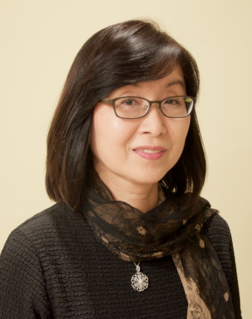Related Research Articles

A tessellation or tiling is the covering of a surface, often a plane, using one or more geometric shapes, called tiles, with no overlaps and no gaps. In mathematics, tessellation can be generalized to higher dimensions and a variety of geometries.

An aperiodic tiling is a non-periodic tiling with the additional property that it does not contain arbitrarily large periodic regions or patches. A set of tile-types is aperiodic if copies of these tiles can form only non-periodic tilings. The Penrose tilings are the best-known examples of aperiodic tilings.
Allan Bertram Borodin is a Canadian-American computer scientist who is a professor at the University of Toronto.
Joan Sylvia Lyttle Birman is an American mathematician, specializing in low-dimensional topology. She has made contributions to the study of knots, 3-manifolds, mapping class groups of surfaces, geometric group theory, contact structures and dynamical systems. Birman is research professor emerita at Barnard College, Columbia University, where she has been since 1973.

The quaquaversal tiling is a nonperiodic tiling of the euclidean 3-space introduced by John Conway and Charles Radin. The basic solid tiles are half prisms arranged in a pattern that relies essentially on their previous construct, the pinwheel tiling. The rotations relating these tiles belong to the group G(6,4) generated by two rotations of order 6 and 4 whose axes are perpendicular to each other. These rotations are dense in SO(3).
In geometry, pinwheel tilings are non-periodic tilings defined by Charles Radin and based on a construction due to John Conway. They are the first known non-periodic tilings to each have the property that their tiles appear in infinitely many orientations.
Alex Eskin is an American mathematician. He is the Arthur Holly Compton Distinguished Service Professor in the Department of Mathematics at the University of Chicago. His research focuses on rational billiards and geometric group theory.

In geometry, Keller's conjecture is the conjecture that in any tiling of n-dimensional Euclidean space by identical hypercubes, there are two hypercubes that share an entire (n − 1)-dimensional face with each other. For instance, in any tiling of the plane by identical squares, some two squares must share an entire edge, as they do in the illustration.

A Pythagorean tiling or two squares tessellation is a tiling of a Euclidean plane by squares of two different sizes, in which each square touches four squares of the other size on its four sides. Many proofs of the Pythagorean theorem are based on it, explaining its name. It is commonly used as a pattern for floor tiles. When used for this, it is also known as a hopscotch pattern or pinwheel pattern, but it should not be confused with the mathematical pinwheel tiling, an unrelated pattern.
Amie Wilkinson is an American mathematician and Professor of Mathematics at the University of Chicago. Her research topics include smooth dynamical systems, ergodic theory, chaos theory and semisimple Lie groups. Wilkinson, in collaboration with Christian Bonatti and Sylvain Crovisier, partially resolved the twelfth problem on Stephen Smale's list of mathematical problems for the 21st Century.

Michael Jeffrey Larsen is an American mathematician, a distinguished professor of mathematics at Indiana University Bloomington.
Matthew Keith "Matt" Franklin is an American cryptographer, and a professor of computer science at the University of California, Davis.

David Archibald Cox is a retired American mathematician, working in algebraic geometry.
In plane geometry, the einstein problem asks about the existence of a single prototile that by itself forms an aperiodic set of prototiles, that is, a shape that can tessellate space, but only in a nonperiodic way. Such a shape is called an "einstein", a play on the German words ein Stein, meaning one tile. Depending on the particular definitions of nonperiodicity and the specifications of what sets may qualify as tiles and what types of matching rules are permitted, the problem is either open or solved. The einstein problem can be seen as a natural extension of the second part of Hilbert's eighteenth problem, which asks for a single polyhedron that tiles Euclidean 3-space, but such that no tessellation by this polyhedron is isohedral. Such anisohedral tiles were found by Karl Reinhardt in 1928, but these anisohedral tiles all tile space periodically.

Lai-Sang Lily Young is a Hong Kong-born American mathematician who holds the Henry & Lucy Moses Professorship of Science and is a professor of mathematics and neural science at the Courant Institute of Mathematical Sciences of New York University. Her research interests include dynamical systems, ergodic theory, chaos theory, probability theory, statistical mechanics, and neuroscience. She is particularly known for introducing the method of Markov returns in 1998, which she used to prove exponential correlation delay in Sinai billiards and other hyperbolic dynamical systems.

Haesun Park is a professor and chair of Computational Science and Engineering at the Georgia Institute of Technology. She is an IEEE Fellow, ACM Fellow, and Society for Industrial and Applied Mathematics Fellow. Park's main areas of research are Numerical Algorithms, Data Analysis, Visual Analytics and Parallel Computing. She has co-authored over 100 articles in peer-reviewed journals and conferences.

William M. Kantor is an American mathematician who works in finite group theory and finite geometries, particularly in computational aspects of these subjects.
Quasicrystals and Geometry is a book on quasicrystals and aperiodic tiling by Marjorie Senechal, published in 1995 by Cambridge University Press (ISBN 0-521-37259-3).
References
- ↑ Stewart, Ian (September 24, 1994), "Bathroom tiling to drive you mad", New Scientist .
- 1 2 Curriculum vitae, retrieved 2013-06-09.
- ↑ Charles Radin at the Mathematics Genealogy Project.
- ↑ List of Fellows of the American Mathematical Society, retrieved 2013-06-09.